MSc International Management Dissertation: Automation & Retention
VerifiedAdded on 2022/02/19
|42
|16020
|37
Thesis and Dissertation
AI Summary
This dissertation, submitted to Teesside University, examines the impact of automation on employee retention within organizations. It investigates the background of automation, its effects on employee redundancy and retention, and the challenges it presents, including the rising unemployment rates and the need for effective training programs. The research aims to evaluate how automation influences employee retention, analyze effective training methods, and provide recommendations for future development to reduce unemployment and social deprivation. The methodology includes a literature review, thematic analysis, and secondary theoretical analysis. The study explores the development of automation in the IT industry, its impact on social and economic growth, and the ways organizations can retain employees through strategic approaches and training. The research structure is divided into introduction, literature review, methodology, results, and conclusion, offering a comprehensive analysis of the topic and actionable recommendations.
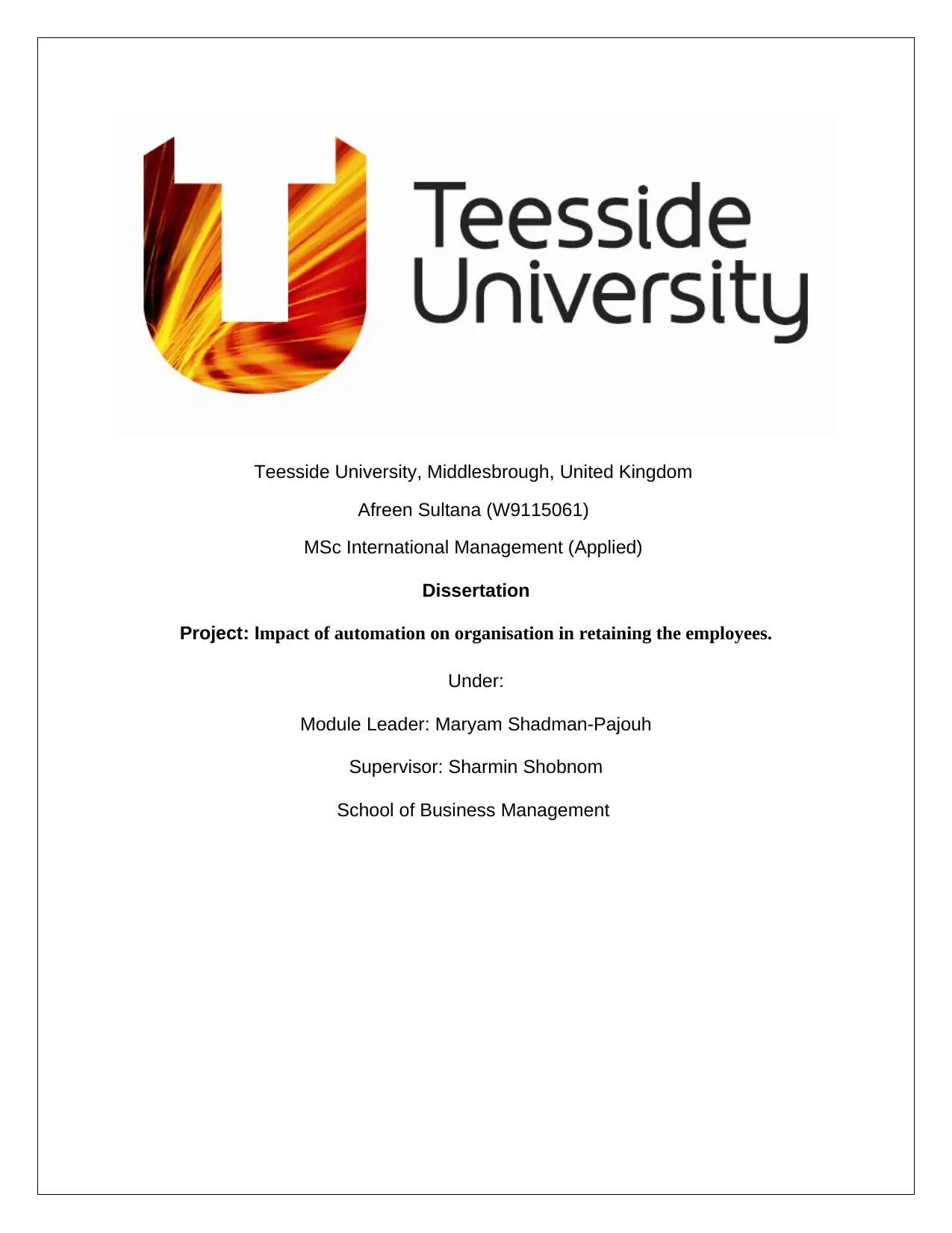
Teesside University, Middlesbrough, United Kingdom
Afreen Sultana (W9115061)
MSc International Management (Applied)
Dissertation
Project: Impact of automation on organisation in retaining the employees.
Under:
Module Leader: Maryam Shadman-Pajouh
Supervisor: Sharmin Shobnom
School of Business Management
Afreen Sultana (W9115061)
MSc International Management (Applied)
Dissertation
Project: Impact of automation on organisation in retaining the employees.
Under:
Module Leader: Maryam Shadman-Pajouh
Supervisor: Sharmin Shobnom
School of Business Management
Paraphrase This Document
Need a fresh take? Get an instant paraphrase of this document with our AI Paraphraser
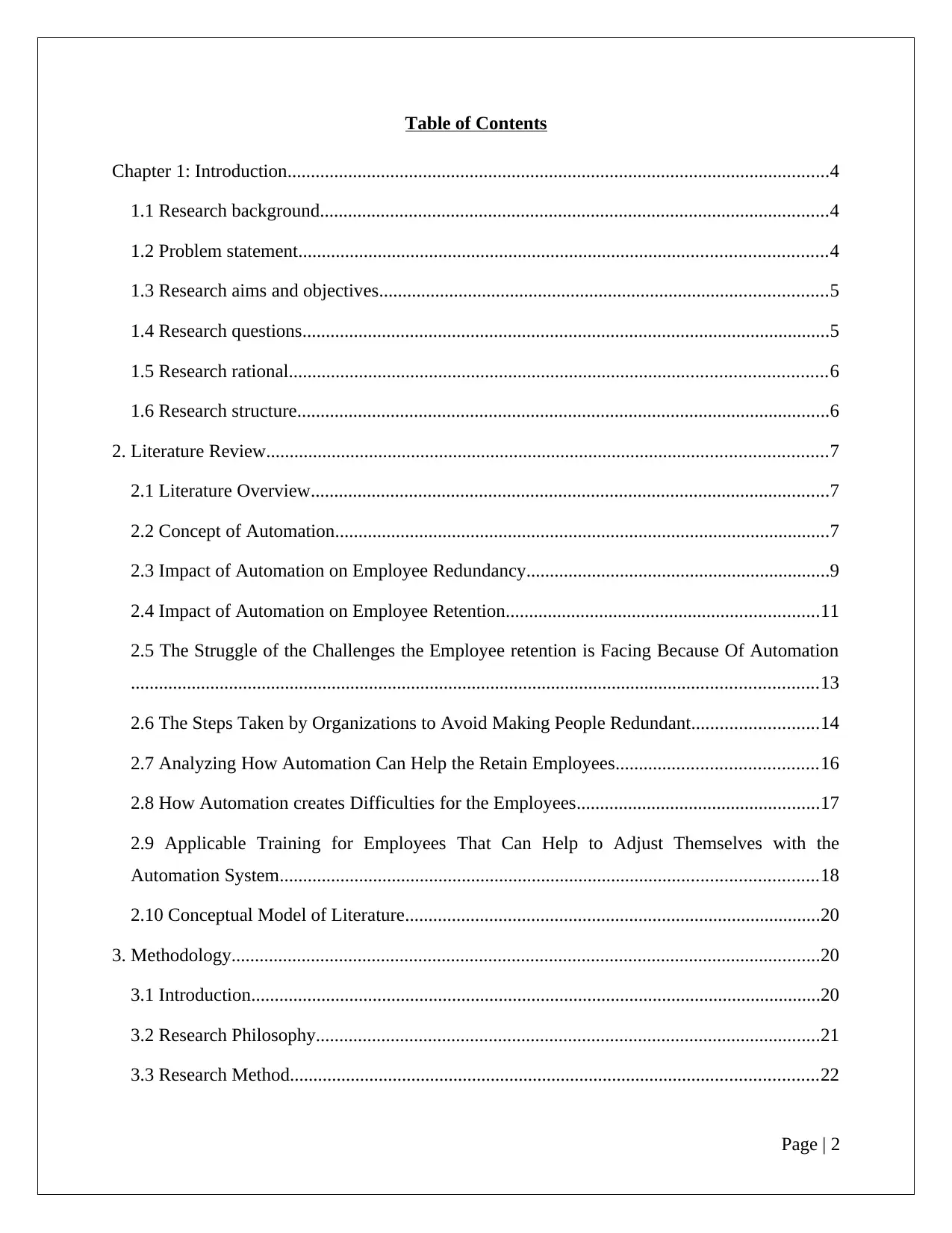
Table of Contents
Chapter 1: Introduction....................................................................................................................4
1.1 Research background.............................................................................................................4
1.2 Problem statement.................................................................................................................4
1.3 Research aims and objectives................................................................................................5
1.4 Research questions.................................................................................................................5
1.5 Research rational...................................................................................................................6
1.6 Research structure..................................................................................................................6
2. Literature Review........................................................................................................................7
2.1 Literature Overview...............................................................................................................7
2.2 Concept of Automation..........................................................................................................7
2.3 Impact of Automation on Employee Redundancy.................................................................9
2.4 Impact of Automation on Employee Retention...................................................................11
2.5 The Struggle of the Challenges the Employee retention is Facing Because Of Automation
...................................................................................................................................................13
2.6 The Steps Taken by Organizations to Avoid Making People Redundant...........................14
2.7 Analyzing How Automation Can Help the Retain Employees...........................................16
2.8 How Automation creates Difficulties for the Employees....................................................17
2.9 Applicable Training for Employees That Can Help to Adjust Themselves with the
Automation System...................................................................................................................18
2.10 Conceptual Model of Literature.........................................................................................20
3. Methodology..............................................................................................................................20
3.1 Introduction..........................................................................................................................20
3.2 Research Philosophy............................................................................................................21
3.3 Research Method.................................................................................................................22
Page | 2
Chapter 1: Introduction....................................................................................................................4
1.1 Research background.............................................................................................................4
1.2 Problem statement.................................................................................................................4
1.3 Research aims and objectives................................................................................................5
1.4 Research questions.................................................................................................................5
1.5 Research rational...................................................................................................................6
1.6 Research structure..................................................................................................................6
2. Literature Review........................................................................................................................7
2.1 Literature Overview...............................................................................................................7
2.2 Concept of Automation..........................................................................................................7
2.3 Impact of Automation on Employee Redundancy.................................................................9
2.4 Impact of Automation on Employee Retention...................................................................11
2.5 The Struggle of the Challenges the Employee retention is Facing Because Of Automation
...................................................................................................................................................13
2.6 The Steps Taken by Organizations to Avoid Making People Redundant...........................14
2.7 Analyzing How Automation Can Help the Retain Employees...........................................16
2.8 How Automation creates Difficulties for the Employees....................................................17
2.9 Applicable Training for Employees That Can Help to Adjust Themselves with the
Automation System...................................................................................................................18
2.10 Conceptual Model of Literature.........................................................................................20
3. Methodology..............................................................................................................................20
3.1 Introduction..........................................................................................................................20
3.2 Research Philosophy............................................................................................................21
3.3 Research Method.................................................................................................................22
Page | 2
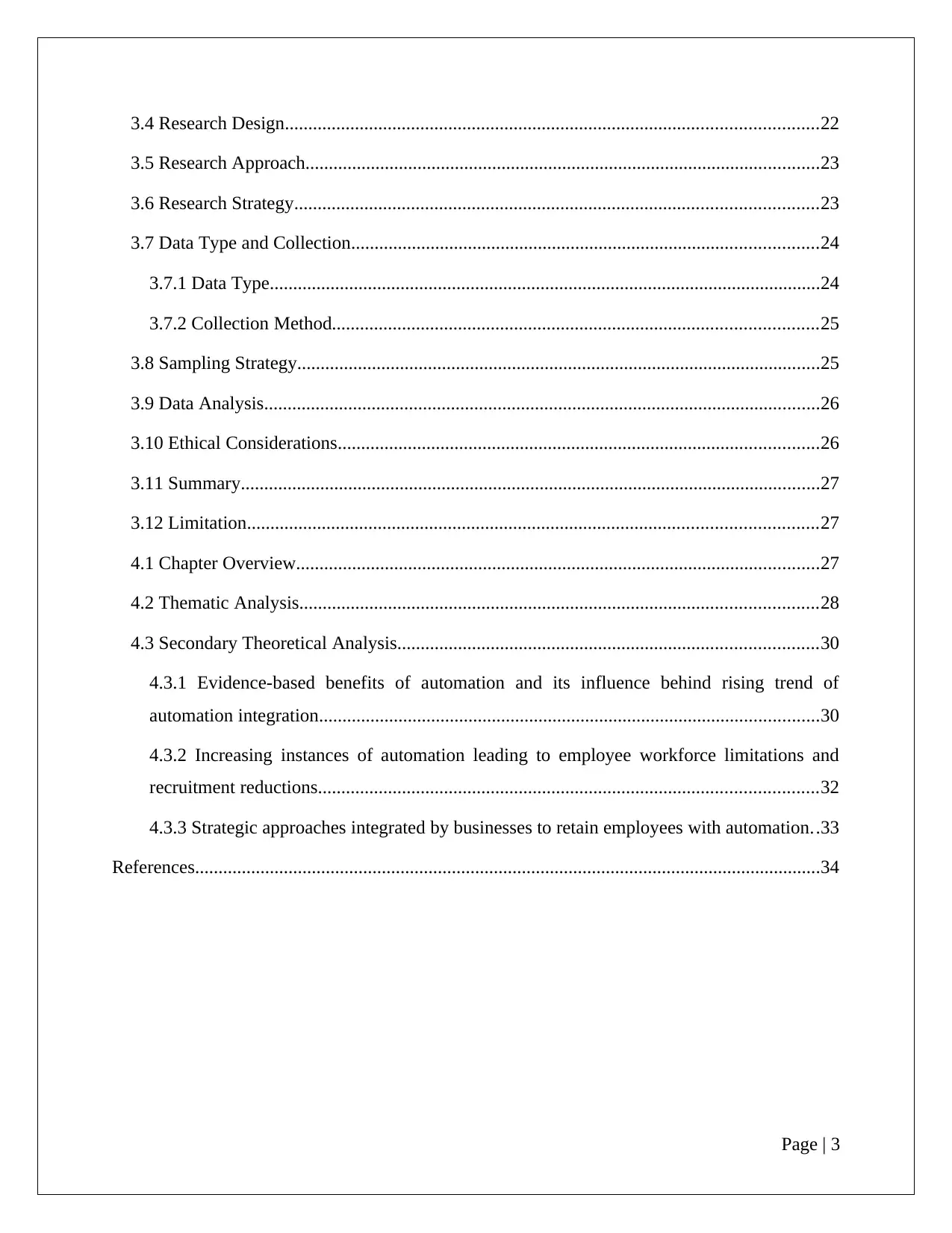
3.4 Research Design..................................................................................................................22
3.5 Research Approach..............................................................................................................23
3.6 Research Strategy................................................................................................................23
3.7 Data Type and Collection....................................................................................................24
3.7.1 Data Type......................................................................................................................24
3.7.2 Collection Method........................................................................................................25
3.8 Sampling Strategy................................................................................................................25
3.9 Data Analysis.......................................................................................................................26
3.10 Ethical Considerations.......................................................................................................26
3.11 Summary............................................................................................................................27
3.12 Limitation..........................................................................................................................27
4.1 Chapter Overview................................................................................................................27
4.2 Thematic Analysis...............................................................................................................28
4.3 Secondary Theoretical Analysis..........................................................................................30
4.3.1 Evidence-based benefits of automation and its influence behind rising trend of
automation integration...........................................................................................................30
4.3.2 Increasing instances of automation leading to employee workforce limitations and
recruitment reductions...........................................................................................................32
4.3.3 Strategic approaches integrated by businesses to retain employees with automation..33
References......................................................................................................................................34
Page | 3
3.5 Research Approach..............................................................................................................23
3.6 Research Strategy................................................................................................................23
3.7 Data Type and Collection....................................................................................................24
3.7.1 Data Type......................................................................................................................24
3.7.2 Collection Method........................................................................................................25
3.8 Sampling Strategy................................................................................................................25
3.9 Data Analysis.......................................................................................................................26
3.10 Ethical Considerations.......................................................................................................26
3.11 Summary............................................................................................................................27
3.12 Limitation..........................................................................................................................27
4.1 Chapter Overview................................................................................................................27
4.2 Thematic Analysis...............................................................................................................28
4.3 Secondary Theoretical Analysis..........................................................................................30
4.3.1 Evidence-based benefits of automation and its influence behind rising trend of
automation integration...........................................................................................................30
4.3.2 Increasing instances of automation leading to employee workforce limitations and
recruitment reductions...........................................................................................................32
4.3.3 Strategic approaches integrated by businesses to retain employees with automation..33
References......................................................................................................................................34
Page | 3
⊘ This is a preview!⊘
Do you want full access?
Subscribe today to unlock all pages.

Trusted by 1+ million students worldwide
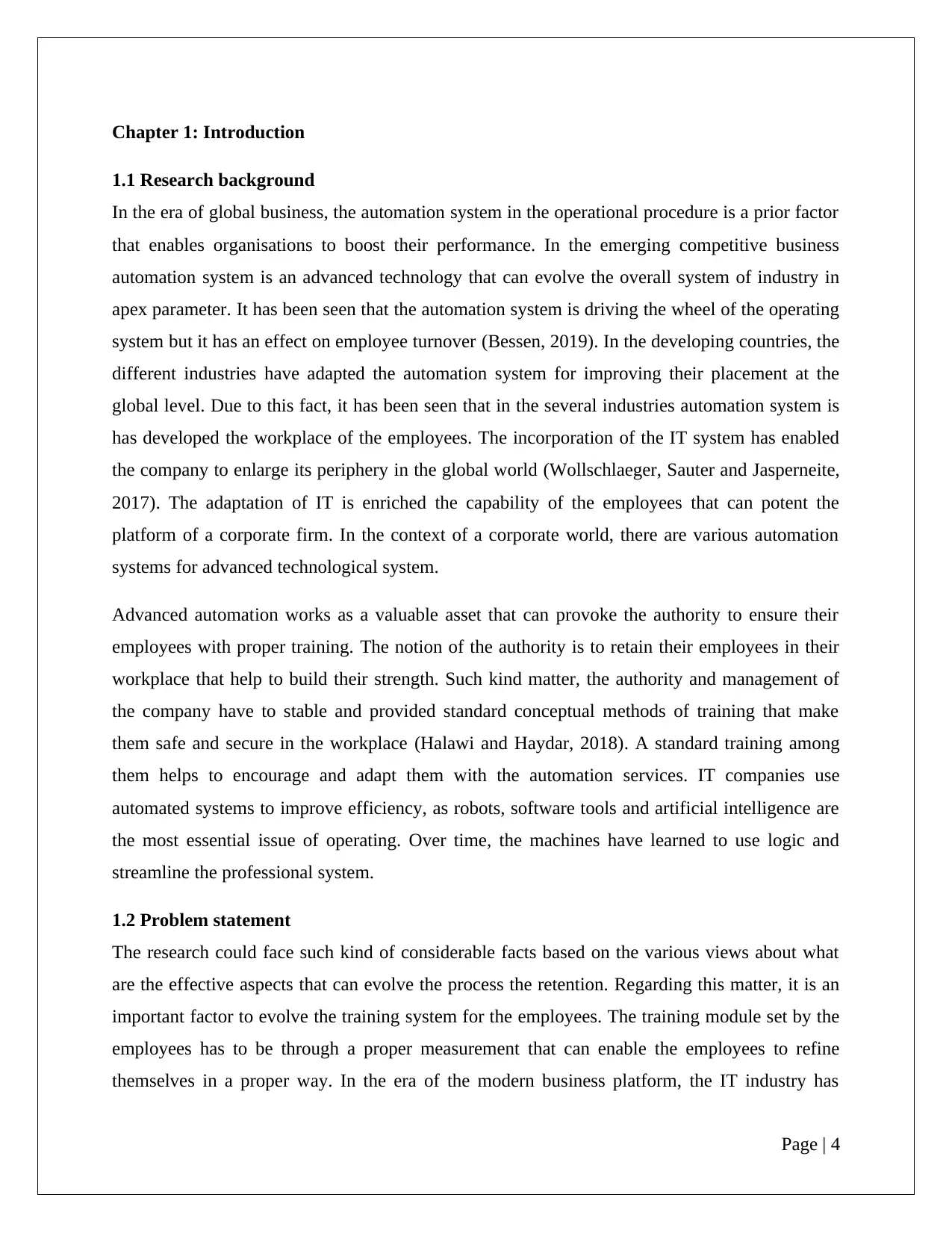
Chapter 1: Introduction
1.1 Research background
In the era of global business, the automation system in the operational procedure is a prior factor
that enables organisations to boost their performance. In the emerging competitive business
automation system is an advanced technology that can evolve the overall system of industry in
apex parameter. It has been seen that the automation system is driving the wheel of the operating
system but it has an effect on employee turnover (Bessen, 2019). In the developing countries, the
different industries have adapted the automation system for improving their placement at the
global level. Due to this fact, it has been seen that in the several industries automation system is
has developed the workplace of the employees. The incorporation of the IT system has enabled
the company to enlarge its periphery in the global world (Wollschlaeger, Sauter and Jasperneite,
2017). The adaptation of IT is enriched the capability of the employees that can potent the
platform of a corporate firm. In the context of a corporate world, there are various automation
systems for advanced technological system.
Advanced automation works as a valuable asset that can provoke the authority to ensure their
employees with proper training. The notion of the authority is to retain their employees in their
workplace that help to build their strength. Such kind matter, the authority and management of
the company have to stable and provided standard conceptual methods of training that make
them safe and secure in the workplace (Halawi and Haydar, 2018). A standard training among
them helps to encourage and adapt them with the automation services. IT companies use
automated systems to improve efficiency, as robots, software tools and artificial intelligence are
the most essential issue of operating. Over time, the machines have learned to use logic and
streamline the professional system.
1.2 Problem statement
The research could face such kind of considerable facts based on the various views about what
are the effective aspects that can evolve the process the retention. Regarding this matter, it is an
important factor to evolve the training system for the employees. The training module set by the
employees has to be through a proper measurement that can enable the employees to refine
themselves in a proper way. In the era of the modern business platform, the IT industry has
Page | 4
1.1 Research background
In the era of global business, the automation system in the operational procedure is a prior factor
that enables organisations to boost their performance. In the emerging competitive business
automation system is an advanced technology that can evolve the overall system of industry in
apex parameter. It has been seen that the automation system is driving the wheel of the operating
system but it has an effect on employee turnover (Bessen, 2019). In the developing countries, the
different industries have adapted the automation system for improving their placement at the
global level. Due to this fact, it has been seen that in the several industries automation system is
has developed the workplace of the employees. The incorporation of the IT system has enabled
the company to enlarge its periphery in the global world (Wollschlaeger, Sauter and Jasperneite,
2017). The adaptation of IT is enriched the capability of the employees that can potent the
platform of a corporate firm. In the context of a corporate world, there are various automation
systems for advanced technological system.
Advanced automation works as a valuable asset that can provoke the authority to ensure their
employees with proper training. The notion of the authority is to retain their employees in their
workplace that help to build their strength. Such kind matter, the authority and management of
the company have to stable and provided standard conceptual methods of training that make
them safe and secure in the workplace (Halawi and Haydar, 2018). A standard training among
them helps to encourage and adapt them with the automation services. IT companies use
automated systems to improve efficiency, as robots, software tools and artificial intelligence are
the most essential issue of operating. Over time, the machines have learned to use logic and
streamline the professional system.
1.2 Problem statement
The research could face such kind of considerable facts based on the various views about what
are the effective aspects that can evolve the process the retention. Regarding this matter, it is an
important factor to evolve the training system for the employees. The training module set by the
employees has to be through a proper measurement that can enable the employees to refine
themselves in a proper way. In the era of the modern business platform, the IT industry has
Page | 4
Paraphrase This Document
Need a fresh take? Get an instant paraphrase of this document with our AI Paraphraser
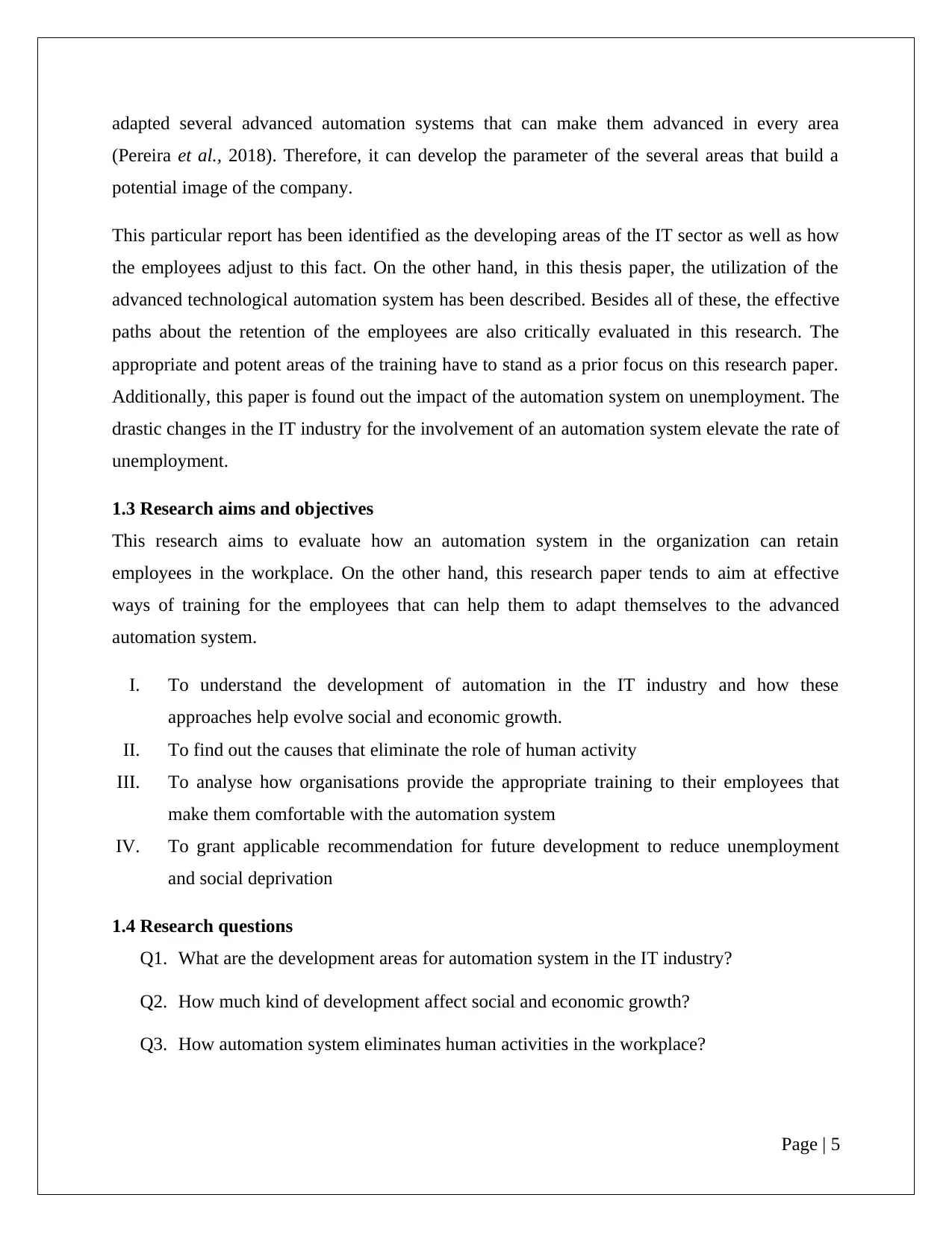
adapted several advanced automation systems that can make them advanced in every area
(Pereira et al., 2018). Therefore, it can develop the parameter of the several areas that build a
potential image of the company.
This particular report has been identified as the developing areas of the IT sector as well as how
the employees adjust to this fact. On the other hand, in this thesis paper, the utilization of the
advanced technological automation system has been described. Besides all of these, the effective
paths about the retention of the employees are also critically evaluated in this research. The
appropriate and potent areas of the training have to stand as a prior focus on this research paper.
Additionally, this paper is found out the impact of the automation system on unemployment. The
drastic changes in the IT industry for the involvement of an automation system elevate the rate of
unemployment.
1.3 Research aims and objectives
This research aims to evaluate how an automation system in the organization can retain
employees in the workplace. On the other hand, this research paper tends to aim at effective
ways of training for the employees that can help them to adapt themselves to the advanced
automation system.
I. To understand the development of automation in the IT industry and how these
approaches help evolve social and economic growth.
II. To find out the causes that eliminate the role of human activity
III. To analyse how organisations provide the appropriate training to their employees that
make them comfortable with the automation system
IV. To grant applicable recommendation for future development to reduce unemployment
and social deprivation
1.4 Research questions
Q1. What are the development areas for automation system in the IT industry?
Q2. How much kind of development affect social and economic growth?
Q3. How automation system eliminates human activities in the workplace?
Page | 5
(Pereira et al., 2018). Therefore, it can develop the parameter of the several areas that build a
potential image of the company.
This particular report has been identified as the developing areas of the IT sector as well as how
the employees adjust to this fact. On the other hand, in this thesis paper, the utilization of the
advanced technological automation system has been described. Besides all of these, the effective
paths about the retention of the employees are also critically evaluated in this research. The
appropriate and potent areas of the training have to stand as a prior focus on this research paper.
Additionally, this paper is found out the impact of the automation system on unemployment. The
drastic changes in the IT industry for the involvement of an automation system elevate the rate of
unemployment.
1.3 Research aims and objectives
This research aims to evaluate how an automation system in the organization can retain
employees in the workplace. On the other hand, this research paper tends to aim at effective
ways of training for the employees that can help them to adapt themselves to the advanced
automation system.
I. To understand the development of automation in the IT industry and how these
approaches help evolve social and economic growth.
II. To find out the causes that eliminate the role of human activity
III. To analyse how organisations provide the appropriate training to their employees that
make them comfortable with the automation system
IV. To grant applicable recommendation for future development to reduce unemployment
and social deprivation
1.4 Research questions
Q1. What are the development areas for automation system in the IT industry?
Q2. How much kind of development affect social and economic growth?
Q3. How automation system eliminates human activities in the workplace?
Page | 5
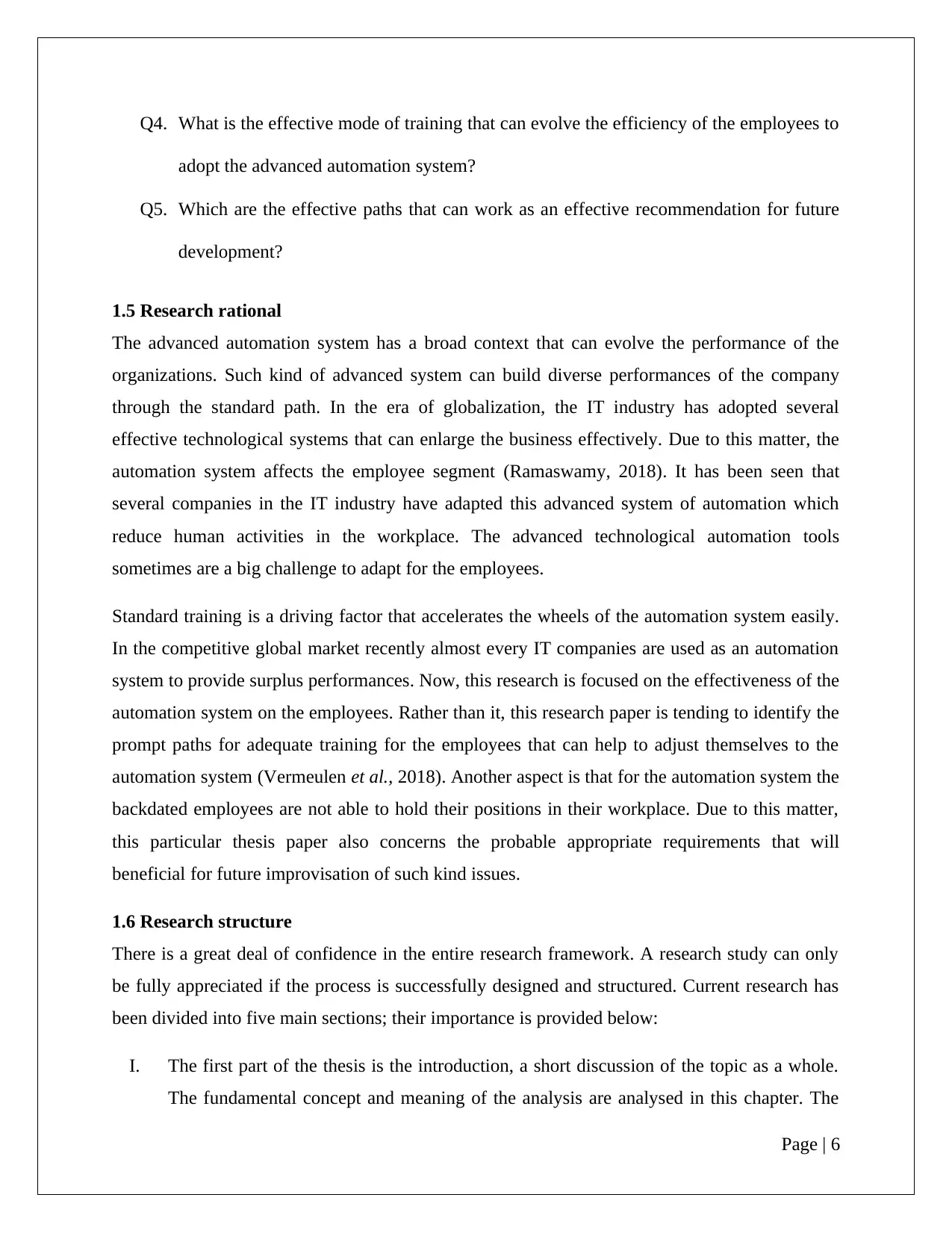
Q4. What is the effective mode of training that can evolve the efficiency of the employees to
adopt the advanced automation system?
Q5. Which are the effective paths that can work as an effective recommendation for future
development?
1.5 Research rational
The advanced automation system has a broad context that can evolve the performance of the
organizations. Such kind of advanced system can build diverse performances of the company
through the standard path. In the era of globalization, the IT industry has adopted several
effective technological systems that can enlarge the business effectively. Due to this matter, the
automation system affects the employee segment (Ramaswamy, 2018). It has been seen that
several companies in the IT industry have adapted this advanced system of automation which
reduce human activities in the workplace. The advanced technological automation tools
sometimes are a big challenge to adapt for the employees.
Standard training is a driving factor that accelerates the wheels of the automation system easily.
In the competitive global market recently almost every IT companies are used as an automation
system to provide surplus performances. Now, this research is focused on the effectiveness of the
automation system on the employees. Rather than it, this research paper is tending to identify the
prompt paths for adequate training for the employees that can help to adjust themselves to the
automation system (Vermeulen et al., 2018). Another aspect is that for the automation system the
backdated employees are not able to hold their positions in their workplace. Due to this matter,
this particular thesis paper also concerns the probable appropriate requirements that will
beneficial for future improvisation of such kind issues.
1.6 Research structure
There is a great deal of confidence in the entire research framework. A research study can only
be fully appreciated if the process is successfully designed and structured. Current research has
been divided into five main sections; their importance is provided below:
I. The first part of the thesis is the introduction, a short discussion of the topic as a whole.
The fundamental concept and meaning of the analysis are analysed in this chapter. The
Page | 6
adopt the advanced automation system?
Q5. Which are the effective paths that can work as an effective recommendation for future
development?
1.5 Research rational
The advanced automation system has a broad context that can evolve the performance of the
organizations. Such kind of advanced system can build diverse performances of the company
through the standard path. In the era of globalization, the IT industry has adopted several
effective technological systems that can enlarge the business effectively. Due to this matter, the
automation system affects the employee segment (Ramaswamy, 2018). It has been seen that
several companies in the IT industry have adapted this advanced system of automation which
reduce human activities in the workplace. The advanced technological automation tools
sometimes are a big challenge to adapt for the employees.
Standard training is a driving factor that accelerates the wheels of the automation system easily.
In the competitive global market recently almost every IT companies are used as an automation
system to provide surplus performances. Now, this research is focused on the effectiveness of the
automation system on the employees. Rather than it, this research paper is tending to identify the
prompt paths for adequate training for the employees that can help to adjust themselves to the
automation system (Vermeulen et al., 2018). Another aspect is that for the automation system the
backdated employees are not able to hold their positions in their workplace. Due to this matter,
this particular thesis paper also concerns the probable appropriate requirements that will
beneficial for future improvisation of such kind issues.
1.6 Research structure
There is a great deal of confidence in the entire research framework. A research study can only
be fully appreciated if the process is successfully designed and structured. Current research has
been divided into five main sections; their importance is provided below:
I. The first part of the thesis is the introduction, a short discussion of the topic as a whole.
The fundamental concept and meaning of the analysis are analysed in this chapter. The
Page | 6
⊘ This is a preview!⊘
Do you want full access?
Subscribe today to unlock all pages.

Trusted by 1+ million students worldwide
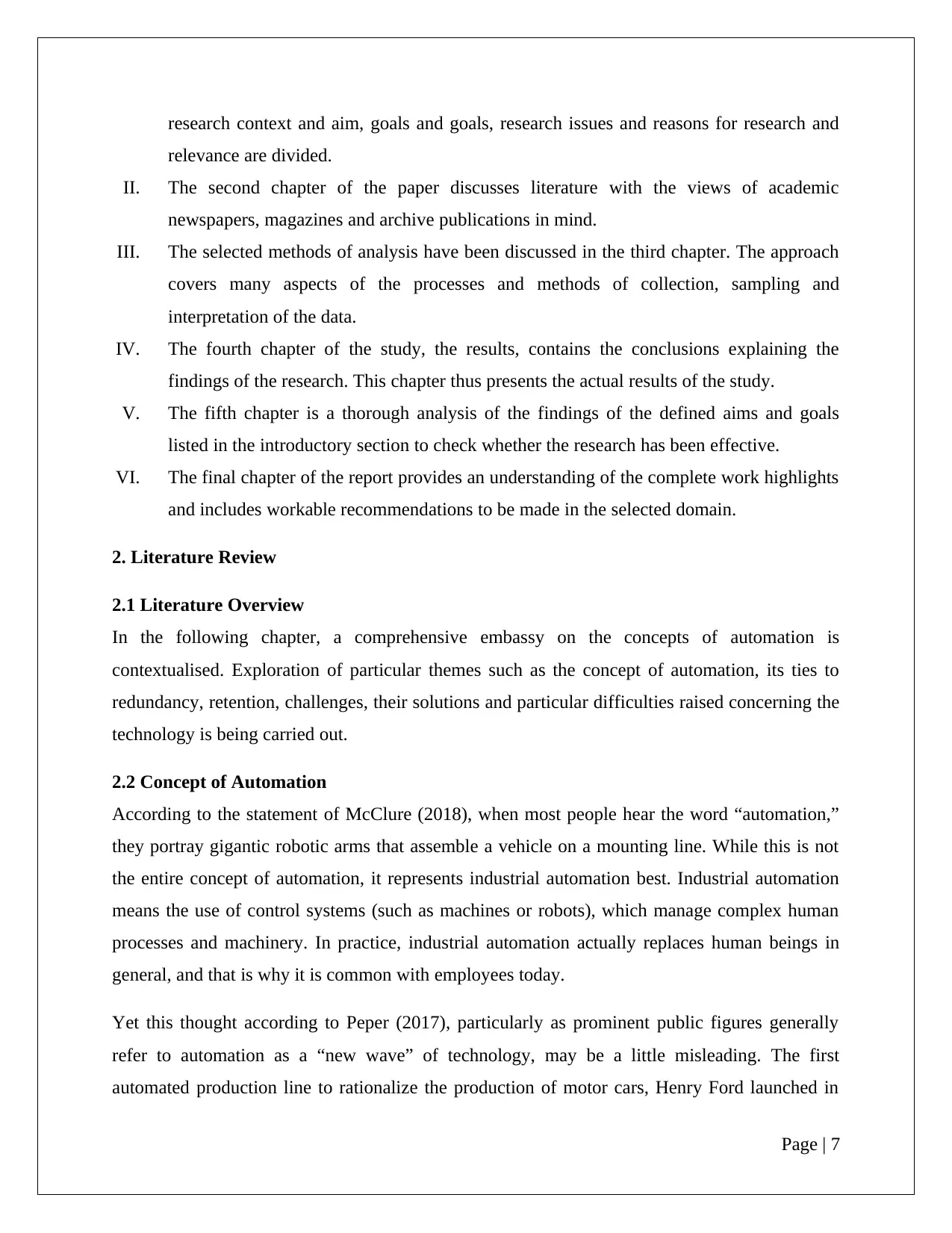
research context and aim, goals and goals, research issues and reasons for research and
relevance are divided.
II. The second chapter of the paper discusses literature with the views of academic
newspapers, magazines and archive publications in mind.
III. The selected methods of analysis have been discussed in the third chapter. The approach
covers many aspects of the processes and methods of collection, sampling and
interpretation of the data.
IV. The fourth chapter of the study, the results, contains the conclusions explaining the
findings of the research. This chapter thus presents the actual results of the study.
V. The fifth chapter is a thorough analysis of the findings of the defined aims and goals
listed in the introductory section to check whether the research has been effective.
VI. The final chapter of the report provides an understanding of the complete work highlights
and includes workable recommendations to be made in the selected domain.
2. Literature Review
2.1 Literature Overview
In the following chapter, a comprehensive embassy on the concepts of automation is
contextualised. Exploration of particular themes such as the concept of automation, its ties to
redundancy, retention, challenges, their solutions and particular difficulties raised concerning the
technology is being carried out.
2.2 Concept of Automation
According to the statement of McClure (2018), when most people hear the word “automation,”
they portray gigantic robotic arms that assemble a vehicle on a mounting line. While this is not
the entire concept of automation, it represents industrial automation best. Industrial automation
means the use of control systems (such as machines or robots), which manage complex human
processes and machinery. In practice, industrial automation actually replaces human beings in
general, and that is why it is common with employees today.
Yet this thought according to Peper (2017), particularly as prominent public figures generally
refer to automation as a “new wave” of technology, may be a little misleading. The first
automated production line to rationalize the production of motor cars, Henry Ford launched in
Page | 7
relevance are divided.
II. The second chapter of the paper discusses literature with the views of academic
newspapers, magazines and archive publications in mind.
III. The selected methods of analysis have been discussed in the third chapter. The approach
covers many aspects of the processes and methods of collection, sampling and
interpretation of the data.
IV. The fourth chapter of the study, the results, contains the conclusions explaining the
findings of the research. This chapter thus presents the actual results of the study.
V. The fifth chapter is a thorough analysis of the findings of the defined aims and goals
listed in the introductory section to check whether the research has been effective.
VI. The final chapter of the report provides an understanding of the complete work highlights
and includes workable recommendations to be made in the selected domain.
2. Literature Review
2.1 Literature Overview
In the following chapter, a comprehensive embassy on the concepts of automation is
contextualised. Exploration of particular themes such as the concept of automation, its ties to
redundancy, retention, challenges, their solutions and particular difficulties raised concerning the
technology is being carried out.
2.2 Concept of Automation
According to the statement of McClure (2018), when most people hear the word “automation,”
they portray gigantic robotic arms that assemble a vehicle on a mounting line. While this is not
the entire concept of automation, it represents industrial automation best. Industrial automation
means the use of control systems (such as machines or robots), which manage complex human
processes and machinery. In practice, industrial automation actually replaces human beings in
general, and that is why it is common with employees today.
Yet this thought according to Peper (2017), particularly as prominent public figures generally
refer to automation as a “new wave” of technology, may be a little misleading. The first
automated production line to rationalize the production of motor cars, Henry Ford launched in
Page | 7
Paraphrase This Document
Need a fresh take? Get an instant paraphrase of this document with our AI Paraphraser
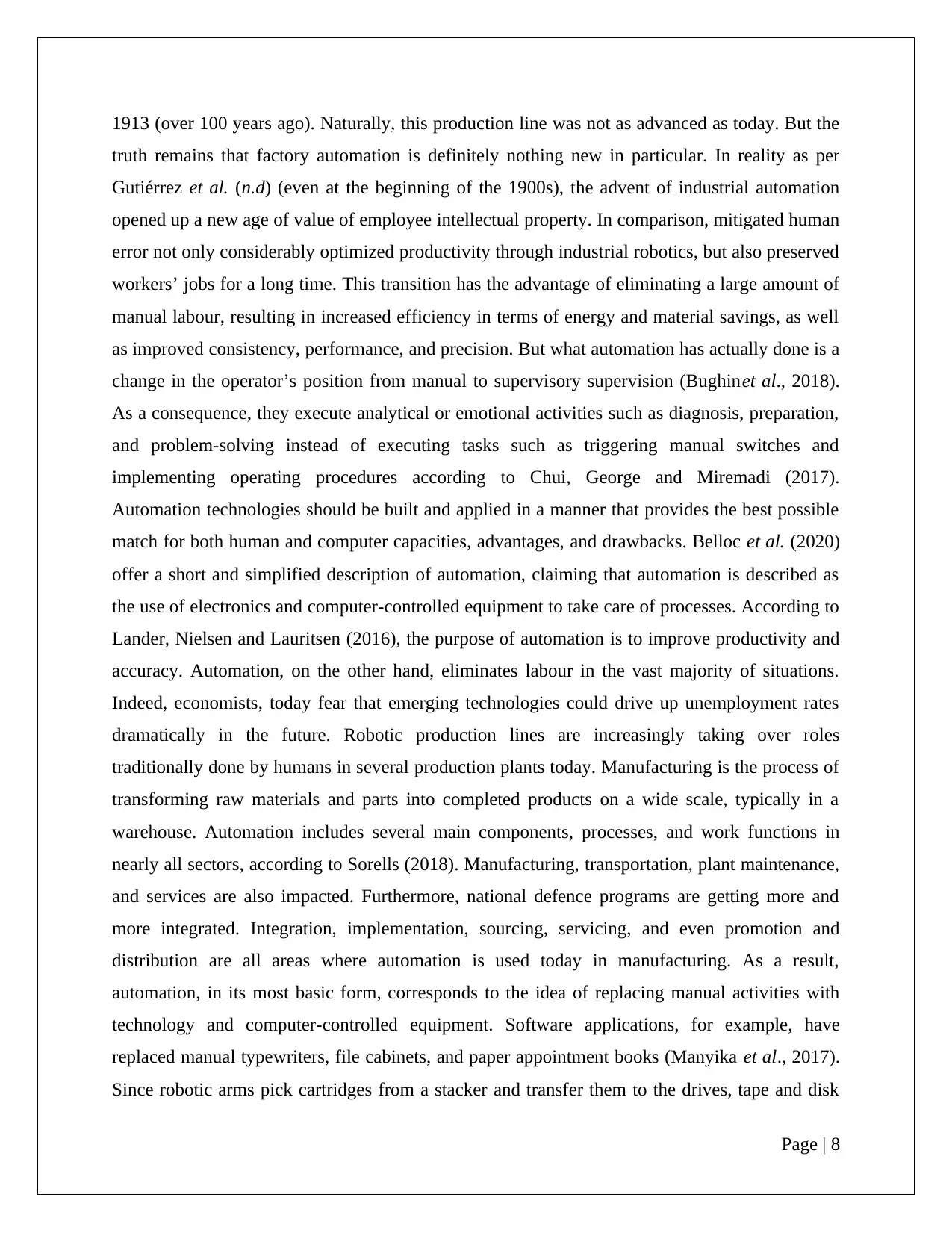
1913 (over 100 years ago). Naturally, this production line was not as advanced as today. But the
truth remains that factory automation is definitely nothing new in particular. In reality as per
Gutiérrez et al. (n.d) (even at the beginning of the 1900s), the advent of industrial automation
opened up a new age of value of employee intellectual property. In comparison, mitigated human
error not only considerably optimized productivity through industrial robotics, but also preserved
workers’ jobs for a long time. This transition has the advantage of eliminating a large amount of
manual labour, resulting in increased efficiency in terms of energy and material savings, as well
as improved consistency, performance, and precision. But what automation has actually done is a
change in the operator’s position from manual to supervisory supervision (Bughinet al., 2018).
As a consequence, they execute analytical or emotional activities such as diagnosis, preparation,
and problem-solving instead of executing tasks such as triggering manual switches and
implementing operating procedures according to Chui, George and Miremadi (2017).
Automation technologies should be built and applied in a manner that provides the best possible
match for both human and computer capacities, advantages, and drawbacks. Belloc et al. (2020)
offer a short and simplified description of automation, claiming that automation is described as
the use of electronics and computer-controlled equipment to take care of processes. According to
Lander, Nielsen and Lauritsen (2016), the purpose of automation is to improve productivity and
accuracy. Automation, on the other hand, eliminates labour in the vast majority of situations.
Indeed, economists, today fear that emerging technologies could drive up unemployment rates
dramatically in the future. Robotic production lines are increasingly taking over roles
traditionally done by humans in several production plants today. Manufacturing is the process of
transforming raw materials and parts into completed products on a wide scale, typically in a
warehouse. Automation includes several main components, processes, and work functions in
nearly all sectors, according to Sorells (2018). Manufacturing, transportation, plant maintenance,
and services are also impacted. Furthermore, national defence programs are getting more and
more integrated. Integration, implementation, sourcing, servicing, and even promotion and
distribution are all areas where automation is used today in manufacturing. As a result,
automation, in its most basic form, corresponds to the idea of replacing manual activities with
technology and computer-controlled equipment. Software applications, for example, have
replaced manual typewriters, file cabinets, and paper appointment books (Manyika et al., 2017).
Since robotic arms pick cartridges from a stacker and transfer them to the drives, tape and disk
Page | 8
truth remains that factory automation is definitely nothing new in particular. In reality as per
Gutiérrez et al. (n.d) (even at the beginning of the 1900s), the advent of industrial automation
opened up a new age of value of employee intellectual property. In comparison, mitigated human
error not only considerably optimized productivity through industrial robotics, but also preserved
workers’ jobs for a long time. This transition has the advantage of eliminating a large amount of
manual labour, resulting in increased efficiency in terms of energy and material savings, as well
as improved consistency, performance, and precision. But what automation has actually done is a
change in the operator’s position from manual to supervisory supervision (Bughinet al., 2018).
As a consequence, they execute analytical or emotional activities such as diagnosis, preparation,
and problem-solving instead of executing tasks such as triggering manual switches and
implementing operating procedures according to Chui, George and Miremadi (2017).
Automation technologies should be built and applied in a manner that provides the best possible
match for both human and computer capacities, advantages, and drawbacks. Belloc et al. (2020)
offer a short and simplified description of automation, claiming that automation is described as
the use of electronics and computer-controlled equipment to take care of processes. According to
Lander, Nielsen and Lauritsen (2016), the purpose of automation is to improve productivity and
accuracy. Automation, on the other hand, eliminates labour in the vast majority of situations.
Indeed, economists, today fear that emerging technologies could drive up unemployment rates
dramatically in the future. Robotic production lines are increasingly taking over roles
traditionally done by humans in several production plants today. Manufacturing is the process of
transforming raw materials and parts into completed products on a wide scale, typically in a
warehouse. Automation includes several main components, processes, and work functions in
nearly all sectors, according to Sorells (2018). Manufacturing, transportation, plant maintenance,
and services are also impacted. Furthermore, national defence programs are getting more and
more integrated. Integration, implementation, sourcing, servicing, and even promotion and
distribution are all areas where automation is used today in manufacturing. As a result,
automation, in its most basic form, corresponds to the idea of replacing manual activities with
technology and computer-controlled equipment. Software applications, for example, have
replaced manual typewriters, file cabinets, and paper appointment books (Manyika et al., 2017).
Since robotic arms pick cartridges from a stacker and transfer them to the drives, tape and disk
Page | 8
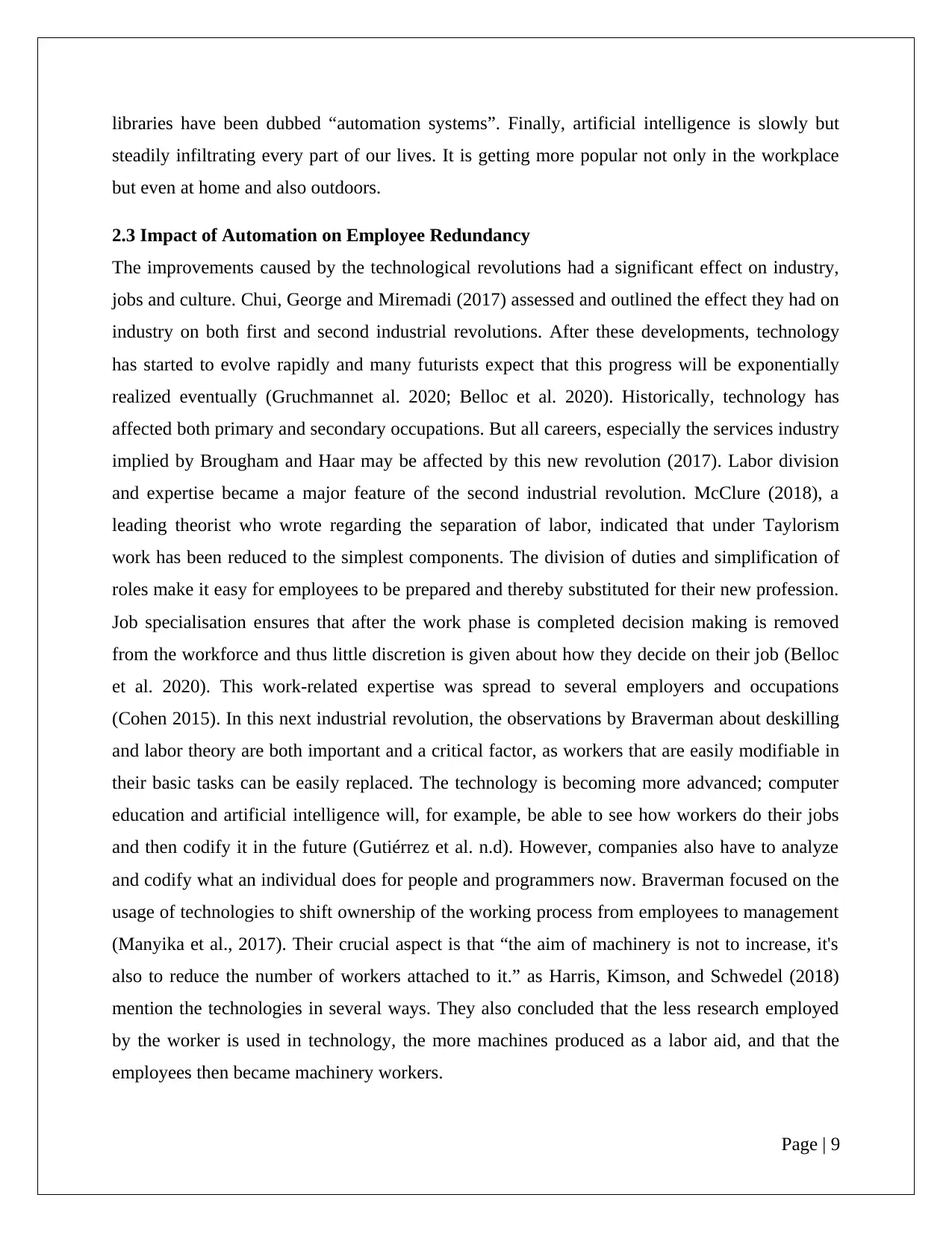
libraries have been dubbed “automation systems”. Finally, artificial intelligence is slowly but
steadily infiltrating every part of our lives. It is getting more popular not only in the workplace
but even at home and also outdoors.
2.3 Impact of Automation on Employee Redundancy
The improvements caused by the technological revolutions had a significant effect on industry,
jobs and culture. Chui, George and Miremadi (2017) assessed and outlined the effect they had on
industry on both first and second industrial revolutions. After these developments, technology
has started to evolve rapidly and many futurists expect that this progress will be exponentially
realized eventually (Gruchmannet al. 2020; Belloc et al. 2020). Historically, technology has
affected both primary and secondary occupations. But all careers, especially the services industry
implied by Brougham and Haar may be affected by this new revolution (2017). Labor division
and expertise became a major feature of the second industrial revolution. McClure (2018), a
leading theorist who wrote regarding the separation of labor, indicated that under Taylorism
work has been reduced to the simplest components. The division of duties and simplification of
roles make it easy for employees to be prepared and thereby substituted for their new profession.
Job specialisation ensures that after the work phase is completed decision making is removed
from the workforce and thus little discretion is given about how they decide on their job (Belloc
et al. 2020). This work-related expertise was spread to several employers and occupations
(Cohen 2015). In this next industrial revolution, the observations by Braverman about deskilling
and labor theory are both important and a critical factor, as workers that are easily modifiable in
their basic tasks can be easily replaced. The technology is becoming more advanced; computer
education and artificial intelligence will, for example, be able to see how workers do their jobs
and then codify it in the future (Gutiérrez et al. n.d). However, companies also have to analyze
and codify what an individual does for people and programmers now. Braverman focused on the
usage of technologies to shift ownership of the working process from employees to management
(Manyika et al., 2017). Their crucial aspect is that “the aim of machinery is not to increase, it's
also to reduce the number of workers attached to it.” as Harris, Kimson, and Schwedel (2018)
mention the technologies in several ways. They also concluded that the less research employed
by the worker is used in technology, the more machines produced as a labor aid, and that the
employees then became machinery workers.
Page | 9
steadily infiltrating every part of our lives. It is getting more popular not only in the workplace
but even at home and also outdoors.
2.3 Impact of Automation on Employee Redundancy
The improvements caused by the technological revolutions had a significant effect on industry,
jobs and culture. Chui, George and Miremadi (2017) assessed and outlined the effect they had on
industry on both first and second industrial revolutions. After these developments, technology
has started to evolve rapidly and many futurists expect that this progress will be exponentially
realized eventually (Gruchmannet al. 2020; Belloc et al. 2020). Historically, technology has
affected both primary and secondary occupations. But all careers, especially the services industry
implied by Brougham and Haar may be affected by this new revolution (2017). Labor division
and expertise became a major feature of the second industrial revolution. McClure (2018), a
leading theorist who wrote regarding the separation of labor, indicated that under Taylorism
work has been reduced to the simplest components. The division of duties and simplification of
roles make it easy for employees to be prepared and thereby substituted for their new profession.
Job specialisation ensures that after the work phase is completed decision making is removed
from the workforce and thus little discretion is given about how they decide on their job (Belloc
et al. 2020). This work-related expertise was spread to several employers and occupations
(Cohen 2015). In this next industrial revolution, the observations by Braverman about deskilling
and labor theory are both important and a critical factor, as workers that are easily modifiable in
their basic tasks can be easily replaced. The technology is becoming more advanced; computer
education and artificial intelligence will, for example, be able to see how workers do their jobs
and then codify it in the future (Gutiérrez et al. n.d). However, companies also have to analyze
and codify what an individual does for people and programmers now. Braverman focused on the
usage of technologies to shift ownership of the working process from employees to management
(Manyika et al., 2017). Their crucial aspect is that “the aim of machinery is not to increase, it's
also to reduce the number of workers attached to it.” as Harris, Kimson, and Schwedel (2018)
mention the technologies in several ways. They also concluded that the less research employed
by the worker is used in technology, the more machines produced as a labor aid, and that the
employees then became machinery workers.
Page | 9
⊘ This is a preview!⊘
Do you want full access?
Subscribe today to unlock all pages.

Trusted by 1+ million students worldwide
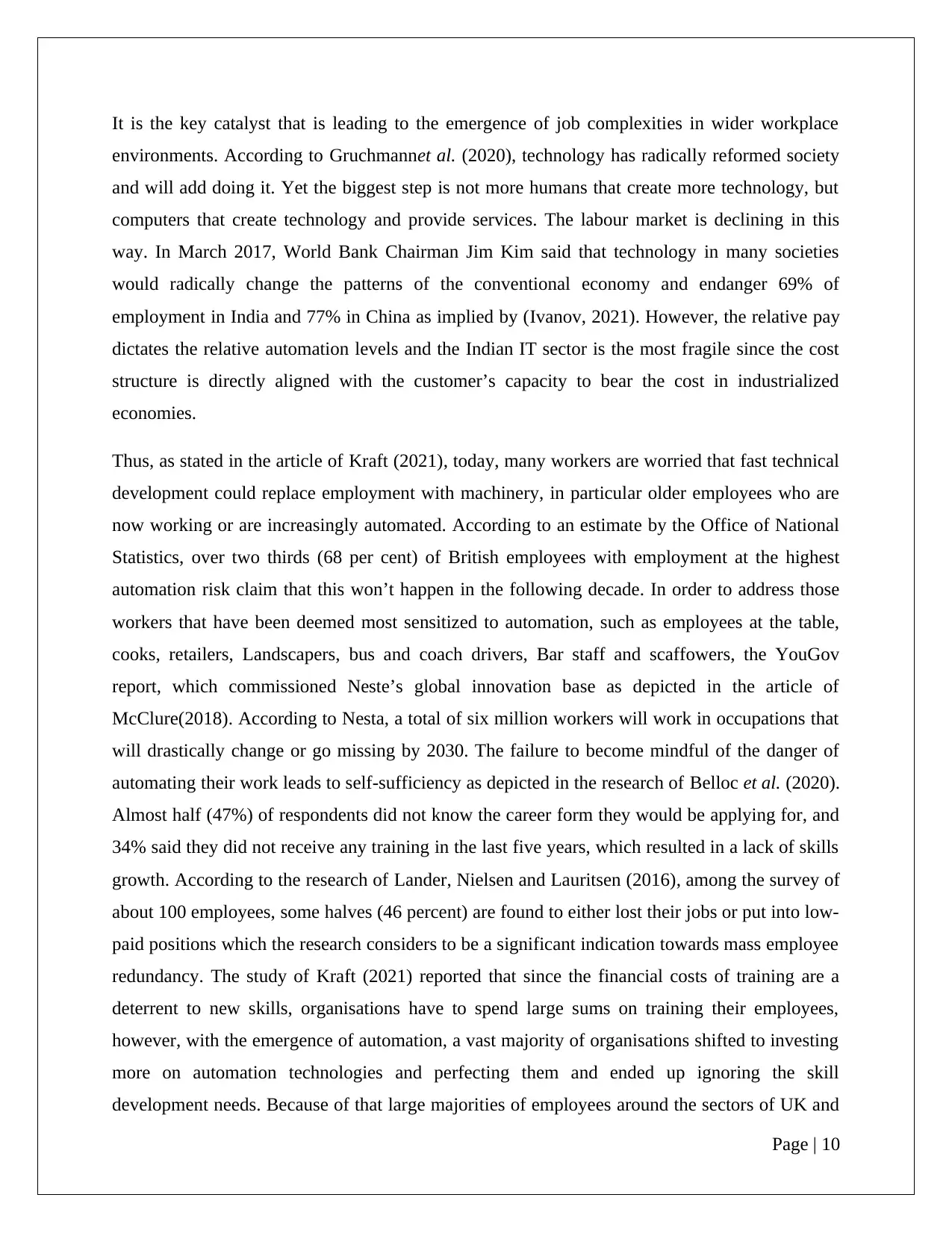
It is the key catalyst that is leading to the emergence of job complexities in wider workplace
environments. According to Gruchmannet al. (2020), technology has radically reformed society
and will add doing it. Yet the biggest step is not more humans that create more technology, but
computers that create technology and provide services. The labour market is declining in this
way. In March 2017, World Bank Chairman Jim Kim said that technology in many societies
would radically change the patterns of the conventional economy and endanger 69% of
employment in India and 77% in China as implied by (Ivanov, 2021). However, the relative pay
dictates the relative automation levels and the Indian IT sector is the most fragile since the cost
structure is directly aligned with the customer’s capacity to bear the cost in industrialized
economies.
Thus, as stated in the article of Kraft (2021), today, many workers are worried that fast technical
development could replace employment with machinery, in particular older employees who are
now working or are increasingly automated. According to an estimate by the Office of National
Statistics, over two thirds (68 per cent) of British employees with employment at the highest
automation risk claim that this won’t happen in the following decade. In order to address those
workers that have been deemed most sensitized to automation, such as employees at the table,
cooks, retailers, Landscapers, bus and coach drivers, Bar staff and scaffowers, the YouGov
report, which commissioned Neste’s global innovation base as depicted in the article of
McClure(2018). According to Nesta, a total of six million workers will work in occupations that
will drastically change or go missing by 2030. The failure to become mindful of the danger of
automating their work leads to self-sufficiency as depicted in the research of Belloc et al. (2020).
Almost half (47%) of respondents did not know the career form they would be applying for, and
34% said they did not receive any training in the last five years, which resulted in a lack of skills
growth. According to the research of Lander, Nielsen and Lauritsen (2016), among the survey of
about 100 employees, some halves (46 percent) are found to either lost their jobs or put into low-
paid positions which the research considers to be a significant indication towards mass employee
redundancy. The study of Kraft (2021) reported that since the financial costs of training are a
deterrent to new skills, organisations have to spend large sums on training their employees,
however, with the emergence of automation, a vast majority of organisations shifted to investing
more on automation technologies and perfecting them and ended up ignoring the skill
development needs. Because of that large majorities of employees around the sectors of UK and
Page | 10
environments. According to Gruchmannet al. (2020), technology has radically reformed society
and will add doing it. Yet the biggest step is not more humans that create more technology, but
computers that create technology and provide services. The labour market is declining in this
way. In March 2017, World Bank Chairman Jim Kim said that technology in many societies
would radically change the patterns of the conventional economy and endanger 69% of
employment in India and 77% in China as implied by (Ivanov, 2021). However, the relative pay
dictates the relative automation levels and the Indian IT sector is the most fragile since the cost
structure is directly aligned with the customer’s capacity to bear the cost in industrialized
economies.
Thus, as stated in the article of Kraft (2021), today, many workers are worried that fast technical
development could replace employment with machinery, in particular older employees who are
now working or are increasingly automated. According to an estimate by the Office of National
Statistics, over two thirds (68 per cent) of British employees with employment at the highest
automation risk claim that this won’t happen in the following decade. In order to address those
workers that have been deemed most sensitized to automation, such as employees at the table,
cooks, retailers, Landscapers, bus and coach drivers, Bar staff and scaffowers, the YouGov
report, which commissioned Neste’s global innovation base as depicted in the article of
McClure(2018). According to Nesta, a total of six million workers will work in occupations that
will drastically change or go missing by 2030. The failure to become mindful of the danger of
automating their work leads to self-sufficiency as depicted in the research of Belloc et al. (2020).
Almost half (47%) of respondents did not know the career form they would be applying for, and
34% said they did not receive any training in the last five years, which resulted in a lack of skills
growth. According to the research of Lander, Nielsen and Lauritsen (2016), among the survey of
about 100 employees, some halves (46 percent) are found to either lost their jobs or put into low-
paid positions which the research considers to be a significant indication towards mass employee
redundancy. The study of Kraft (2021) reported that since the financial costs of training are a
deterrent to new skills, organisations have to spend large sums on training their employees,
however, with the emergence of automation, a vast majority of organisations shifted to investing
more on automation technologies and perfecting them and ended up ignoring the skill
development needs. Because of that large majorities of employees around the sectors of UK and
Page | 10
Paraphrase This Document
Need a fresh take? Get an instant paraphrase of this document with our AI Paraphraser
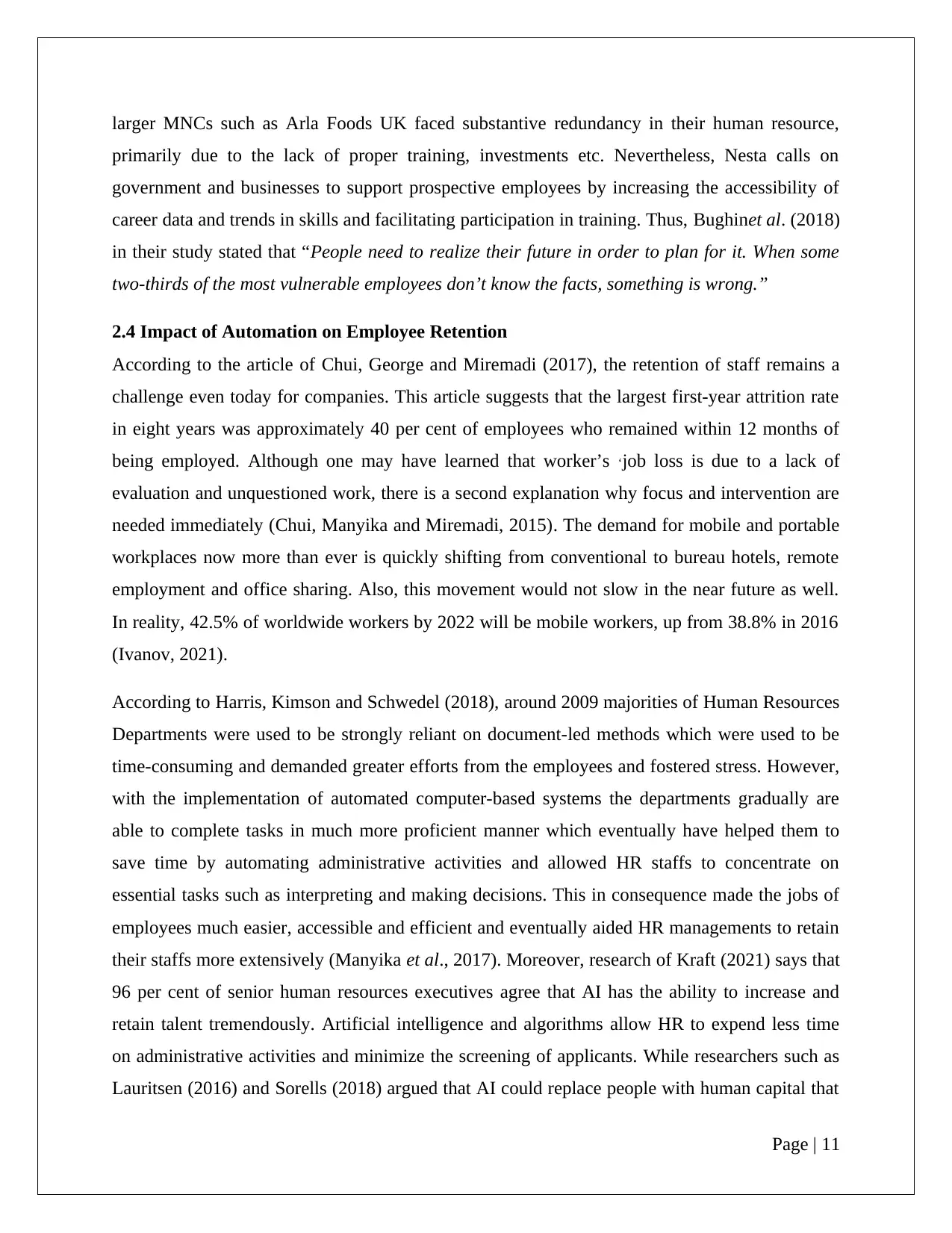
larger MNCs such as Arla Foods UK faced substantive redundancy in their human resource,
primarily due to the lack of proper training, investments etc. Nevertheless, Nesta calls on
government and businesses to support prospective employees by increasing the accessibility of
career data and trends in skills and facilitating participation in training. Thus, Bughinet al. (2018)
in their study stated that “People need to realize their future in order to plan for it. When some
two-thirds of the most vulnerable employees don’t know the facts, something is wrong.”
2.4 Impact of Automation on Employee Retention
According to the article of Chui, George and Miremadi (2017), the retention of staff remains a
challenge even today for companies. This article suggests that the largest first-year attrition rate
in eight years was approximately 40 per cent of employees who remained within 12 months of
being employed. Although one may have learned that worker’s ‘job loss is due to a lack of
evaluation and unquestioned work, there is a second explanation why focus and intervention are
needed immediately (Chui, Manyika and Miremadi, 2015). The demand for mobile and portable
workplaces now more than ever is quickly shifting from conventional to bureau hotels, remote
employment and office sharing. Also, this movement would not slow in the near future as well.
In reality, 42.5% of worldwide workers by 2022 will be mobile workers, up from 38.8% in 2016
(Ivanov, 2021).
According to Harris, Kimson and Schwedel (2018), around 2009 majorities of Human Resources
Departments were used to be strongly reliant on document-led methods which were used to be
time-consuming and demanded greater efforts from the employees and fostered stress. However,
with the implementation of automated computer-based systems the departments gradually are
able to complete tasks in much more proficient manner which eventually have helped them to
save time by automating administrative activities and allowed HR staffs to concentrate on
essential tasks such as interpreting and making decisions. This in consequence made the jobs of
employees much easier, accessible and efficient and eventually aided HR managements to retain
their staffs more extensively (Manyika et al., 2017). Moreover, research of Kraft (2021) says that
96 per cent of senior human resources executives agree that AI has the ability to increase and
retain talent tremendously. Artificial intelligence and algorithms allow HR to expend less time
on administrative activities and minimize the screening of applicants. While researchers such as
Lauritsen (2016) and Sorells (2018) argued that AI could replace people with human capital that
Page | 11
primarily due to the lack of proper training, investments etc. Nevertheless, Nesta calls on
government and businesses to support prospective employees by increasing the accessibility of
career data and trends in skills and facilitating participation in training. Thus, Bughinet al. (2018)
in their study stated that “People need to realize their future in order to plan for it. When some
two-thirds of the most vulnerable employees don’t know the facts, something is wrong.”
2.4 Impact of Automation on Employee Retention
According to the article of Chui, George and Miremadi (2017), the retention of staff remains a
challenge even today for companies. This article suggests that the largest first-year attrition rate
in eight years was approximately 40 per cent of employees who remained within 12 months of
being employed. Although one may have learned that worker’s ‘job loss is due to a lack of
evaluation and unquestioned work, there is a second explanation why focus and intervention are
needed immediately (Chui, Manyika and Miremadi, 2015). The demand for mobile and portable
workplaces now more than ever is quickly shifting from conventional to bureau hotels, remote
employment and office sharing. Also, this movement would not slow in the near future as well.
In reality, 42.5% of worldwide workers by 2022 will be mobile workers, up from 38.8% in 2016
(Ivanov, 2021).
According to Harris, Kimson and Schwedel (2018), around 2009 majorities of Human Resources
Departments were used to be strongly reliant on document-led methods which were used to be
time-consuming and demanded greater efforts from the employees and fostered stress. However,
with the implementation of automated computer-based systems the departments gradually are
able to complete tasks in much more proficient manner which eventually have helped them to
save time by automating administrative activities and allowed HR staffs to concentrate on
essential tasks such as interpreting and making decisions. This in consequence made the jobs of
employees much easier, accessible and efficient and eventually aided HR managements to retain
their staffs more extensively (Manyika et al., 2017). Moreover, research of Kraft (2021) says that
96 per cent of senior human resources executives agree that AI has the ability to increase and
retain talent tremendously. Artificial intelligence and algorithms allow HR to expend less time
on administrative activities and minimize the screening of applicants. While researchers such as
Lauritsen (2016) and Sorells (2018) argued that AI could replace people with human capital that
Page | 11
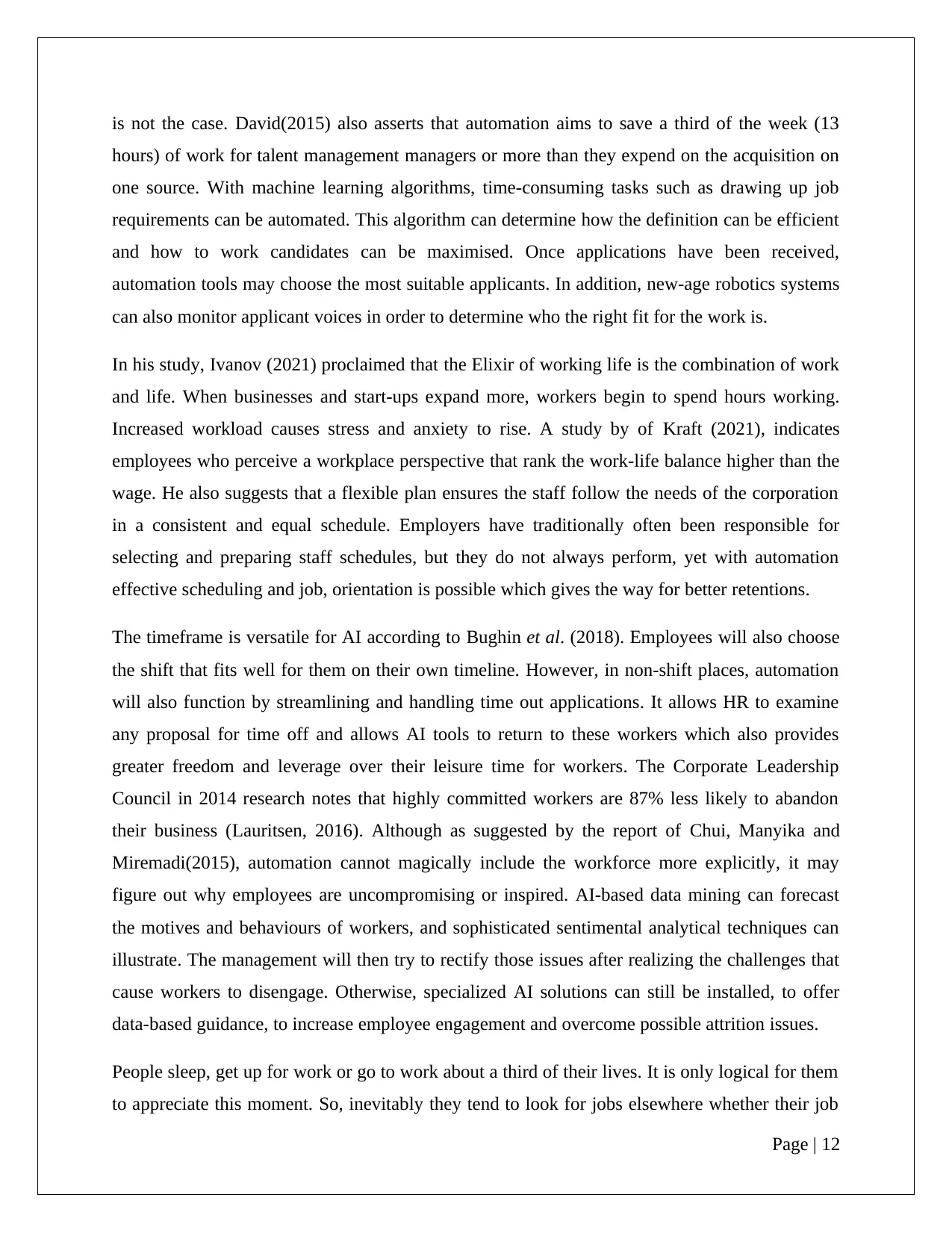
is not the case. David(2015) also asserts that automation aims to save a third of the week (13
hours) of work for talent management managers or more than they expend on the acquisition on
one source. With machine learning algorithms, time-consuming tasks such as drawing up job
requirements can be automated. This algorithm can determine how the definition can be efficient
and how to work candidates can be maximised. Once applications have been received,
automation tools may choose the most suitable applicants. In addition, new-age robotics systems
can also monitor applicant voices in order to determine who the right fit for the work is.
In his study, Ivanov (2021) proclaimed that the Elixir of working life is the combination of work
and life. When businesses and start-ups expand more, workers begin to spend hours working.
Increased workload causes stress and anxiety to rise. A study by of Kraft (2021), indicates
employees who perceive a workplace perspective that rank the work-life balance higher than the
wage. He also suggests that a flexible plan ensures the staff follow the needs of the corporation
in a consistent and equal schedule. Employers have traditionally often been responsible for
selecting and preparing staff schedules, but they do not always perform, yet with automation
effective scheduling and job, orientation is possible which gives the way for better retentions.
The timeframe is versatile for AI according to Bughin et al. (2018). Employees will also choose
the shift that fits well for them on their own timeline. However, in non-shift places, automation
will also function by streamlining and handling time out applications. It allows HR to examine
any proposal for time off and allows AI tools to return to these workers which also provides
greater freedom and leverage over their leisure time for workers. The Corporate Leadership
Council in 2014 research notes that highly committed workers are 87% less likely to abandon
their business (Lauritsen, 2016). Although as suggested by the report of Chui, Manyika and
Miremadi(2015), automation cannot magically include the workforce more explicitly, it may
figure out why employees are uncompromising or inspired. AI-based data mining can forecast
the motives and behaviours of workers, and sophisticated sentimental analytical techniques can
illustrate. The management will then try to rectify those issues after realizing the challenges that
cause workers to disengage. Otherwise, specialized AI solutions can still be installed, to offer
data-based guidance, to increase employee engagement and overcome possible attrition issues.
People sleep, get up for work or go to work about a third of their lives. It is only logical for them
to appreciate this moment. So, inevitably they tend to look for jobs elsewhere whether their job
Page | 12
hours) of work for talent management managers or more than they expend on the acquisition on
one source. With machine learning algorithms, time-consuming tasks such as drawing up job
requirements can be automated. This algorithm can determine how the definition can be efficient
and how to work candidates can be maximised. Once applications have been received,
automation tools may choose the most suitable applicants. In addition, new-age robotics systems
can also monitor applicant voices in order to determine who the right fit for the work is.
In his study, Ivanov (2021) proclaimed that the Elixir of working life is the combination of work
and life. When businesses and start-ups expand more, workers begin to spend hours working.
Increased workload causes stress and anxiety to rise. A study by of Kraft (2021), indicates
employees who perceive a workplace perspective that rank the work-life balance higher than the
wage. He also suggests that a flexible plan ensures the staff follow the needs of the corporation
in a consistent and equal schedule. Employers have traditionally often been responsible for
selecting and preparing staff schedules, but they do not always perform, yet with automation
effective scheduling and job, orientation is possible which gives the way for better retentions.
The timeframe is versatile for AI according to Bughin et al. (2018). Employees will also choose
the shift that fits well for them on their own timeline. However, in non-shift places, automation
will also function by streamlining and handling time out applications. It allows HR to examine
any proposal for time off and allows AI tools to return to these workers which also provides
greater freedom and leverage over their leisure time for workers. The Corporate Leadership
Council in 2014 research notes that highly committed workers are 87% less likely to abandon
their business (Lauritsen, 2016). Although as suggested by the report of Chui, Manyika and
Miremadi(2015), automation cannot magically include the workforce more explicitly, it may
figure out why employees are uncompromising or inspired. AI-based data mining can forecast
the motives and behaviours of workers, and sophisticated sentimental analytical techniques can
illustrate. The management will then try to rectify those issues after realizing the challenges that
cause workers to disengage. Otherwise, specialized AI solutions can still be installed, to offer
data-based guidance, to increase employee engagement and overcome possible attrition issues.
People sleep, get up for work or go to work about a third of their lives. It is only logical for them
to appreciate this moment. So, inevitably they tend to look for jobs elsewhere whether their job
Page | 12
⊘ This is a preview!⊘
Do you want full access?
Subscribe today to unlock all pages.

Trusted by 1+ million students worldwide
1 out of 42
Related Documents
Your All-in-One AI-Powered Toolkit for Academic Success.
+13062052269
info@desklib.com
Available 24*7 on WhatsApp / Email
![[object Object]](/_next/static/media/star-bottom.7253800d.svg)
Unlock your academic potential
Copyright © 2020–2025 A2Z Services. All Rights Reserved. Developed and managed by ZUCOL.





